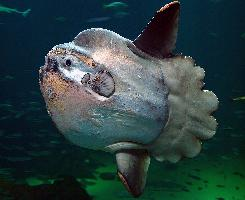
Weights and measures
| Weight | 1000 kg |
|---|
State of endangerment
| Endangered |
Animal description
The Ocean sunfish, scientifically known as Mola mola, is an extraordinary and fascinating marine creature that defies the typical fish archetype with its unique appearance and behaviors. This colossal fish is most notable for its peculiar shape and immense size, making it one of the heaviest known bony fishes in the world. The Mola mola can be found in temperate and tropical oceans worldwide, where it prefers the open water, drifting with ocean currents.Physically, the Ocean sunfish is unlike any other fish in the ocean. Its body is flattened laterally, giving it a distinctly disc-like shape. This unusual body form is further accentuated by the absence of a true tail. Instead, the sunfish has a clavus, a rudder-like structure that evolved from the fusion of its dorsal and anal fins. This unique adaptation assists in its navigation through the vast oceanic waters. The sunfish's skin is leathery and thick, with a texture often described as rough, and it can be mottled with various patterns that help camouflage it in the water. Its coloration ranges from silvery-gray to brown, with a lighter underside.
Adult Mola mola are gigantic, often measuring up to 3 meters (10 feet) in length from fin to fin, and can weigh as much as 2,000 kilograms (4,400 pounds), although there are reports of specimens reaching even greater sizes. Despite their massive bulk, sunfish are gentle giants, feeding primarily on jellyfish, zooplankton, small fish, and algae. Their diet is surprisingly low in nutritional value, which necessitates the consumption of vast amounts of food to sustain their large size.
One of the most remarkable aspects of the Ocean sunfish's biology is its reproductive capacity. A female Mola mola holds the record for the most eggs produced by any known vertebrate, with one individual capable of releasing over 300 million eggs at once. However, due to predation and the challenges of surviving in the open ocean, only a tiny fraction of these eggs will reach adulthood.
Behaviorally, sunfish are known for their basking behavior. They are often observed lying on their side at the ocean's surface, soaking up the sun's rays. This peculiar behavior is thought to serve multiple purposes, including thermoregulation after deep, cold water dives in search of food, and inviting seabirds to rid them of parasites. Despite their bulky size and seemingly awkward shape, Mola mola are capable of vertical migrations, diving to depths of over 600 meters (2000 feet) to feed.
The Ocean sunfish faces several threats, including entanglement in fishing nets, collisions with boats, and the ingestion of plastic debris mistaken for jellyfish. Despite these challenges, the Mola mola remains a resilient species, captivating the curiosity and wonder of scientists and ocean enthusiasts alike.
In conclusion, the Ocean sunfish is a remarkable creature that embodies the mystery and majesty of the marine world. Its unique physical attributes, gentle demeanor, and fascinating behaviors make it one of the ocean's most intriguing inhabitants. As research continues, the Mola mola will undoubtedly reveal even more secrets about its life in the vast, open oceans of our planet.
New photos of animals
Top 10 animals
- Dolphin gull (Leucophaeus scoresbii)
- Japanese macaque (Macaca fuscata)
- Stone loach (Barbatula barbatula)
- Greek tortoise (Testudo graeca)
- Russian tortoise (Testudo horsfieldii)
- Galápagos tortoise (Geochelone nigra complex)
- Diana monkey (Cercopithecus diana)
- Moustached guenon (Cercopithecus cephus)
- Galápagos penguin (Spheniscus mendiculus)
- Common flying dragon (Draco volans)